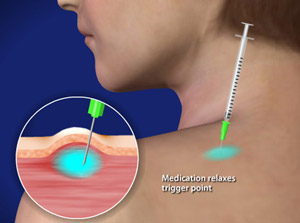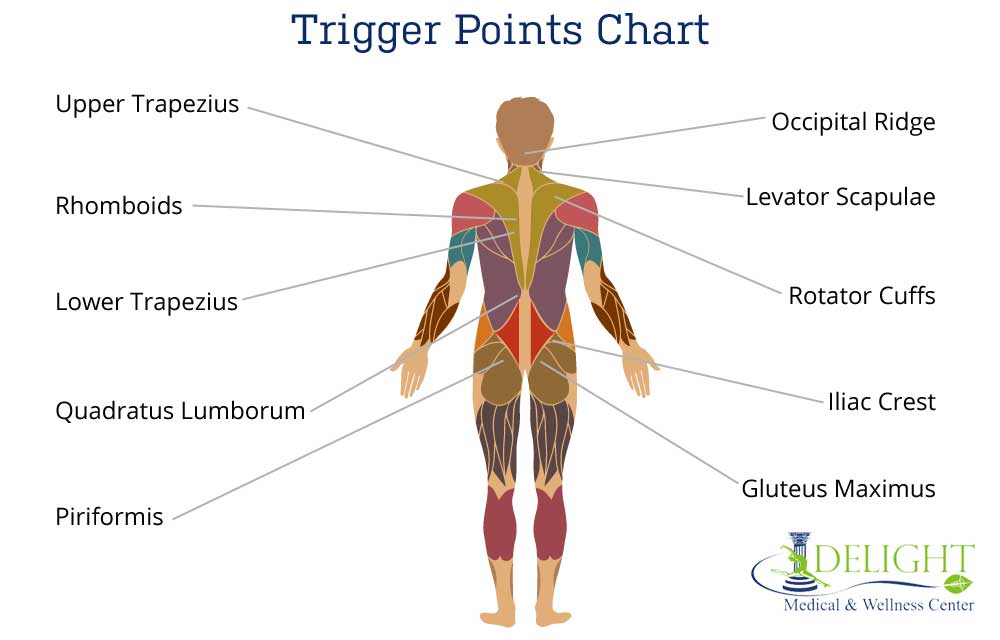Trigger Points and Referral Pain
December 2019
 What are Trigger Points?
What are Trigger Points?
Trigger points, also known as “knots”, are hypersensitive tender points within the fascia that surrounds skeletal muscle. They can sometimes be felt as nodules in tightly contracted muscle bands and are often times associated with musculoskeletal issue. Trigger Points are the most common source of pain that may be caused by stress, injury, strain, overuse or bad posture and can radiate from a localized focal point into another surrounding area associated with a twitch response. Trigger Points may also decrease an individual’s range of motion (ROM) due to the pain, tightness or stiffness of the affected muscle and can cause an autonomic response if compressed. There are two different types of Trigger Points: Active Trigger Points and Latent Trigger Points that an individual may experience.
According to an article by in the American Academy of Family Physicians, Active Trigger Points and Latent trigger points are classified based on their characteristics. The article stated that active trigger points “…causes pain at rest. It is tender to palpation with a referred pain pattern that is similar to the patient’s pain complaint.” And that a latent trigger point “…does not cause spontaneous pain, but may restrict movement or cause muscle weakness. The patient presenting with muscle restrictions or weakness may become aware of pain originating from a latent trigger point only when pressure is applied directly over the point.”

Trigger Points are unique and are very difficult to diagnose due to its nature. Because Trigger Points are complicated and may be caused by a multitude of factors, other underlying issues that are causing the Trigger Points may be ignored or misdiagnosed. For instance, Trigger points can sometimes be mistaken or misdiagnosed as Fibromyalgia syndrome because it consists of multiple tender points or spots, similar to Trigger points. Although they present similar symptoms, they are both very different conditions. In order to assure that you are receiving the best and most accurate diagnosis and care, see an Osteopathic Physician who specializes in prevention, diagnosis, and treatment of the Muscular skeletal system.
What is Referral Pain?
The difficulty of treating Trigger points is due to their unique mechanism of causing referred pain. Referral or referred pain is when there is pain in a specific muscle but creates pain in another area of the body. For example, if there is a trigger point in the Trapezius muscle (upper back/ Shoulder area), it can refer pain up towards the head and neck and cause tension headaches or even migraines.
I heard about Delight Medical through living social. I started coming in for prolotherapy and I would highly recommend it for athletes. I’m a runner and it’s helped me with a hip injury. It’s helping to strengthen my hips so I can get out there and run again. It’s also helpful in my jaw for TMJ; I would highly recommend this treatment for people that suffer from TMJ. I’ve tried a lot of different things and this has been very helpful.
I’m also doing the trigger point therapy, which is really great for people that carry a lot of stress in their upper back area, which is what happens to me, and it helps relax things when massages and other things don’t work. I would highly recommend that as a great way to release stress. I like coming here because when I leave I feel a lot better.
Wendy
Trigger Point Treatments
There are a multitude of ways to treat trigger point pain such as Trigger Point Injections where a skilled physician injects the trigger points with a special solution to increase blood flow to the area and to relax the affected muscle. Other methods are Osteopathic manual therapy, transcutaneous electrical nerve stimulation, massage, heat application, and acupressure. But to determine which treatment is best, you should see an Osteopathic Physician who can give an accurate evaluation and depending on your pain and symptoms, they can give you the best comprehensive treatment approach as well as find any other underlying issues that may be causing the trigger points.



